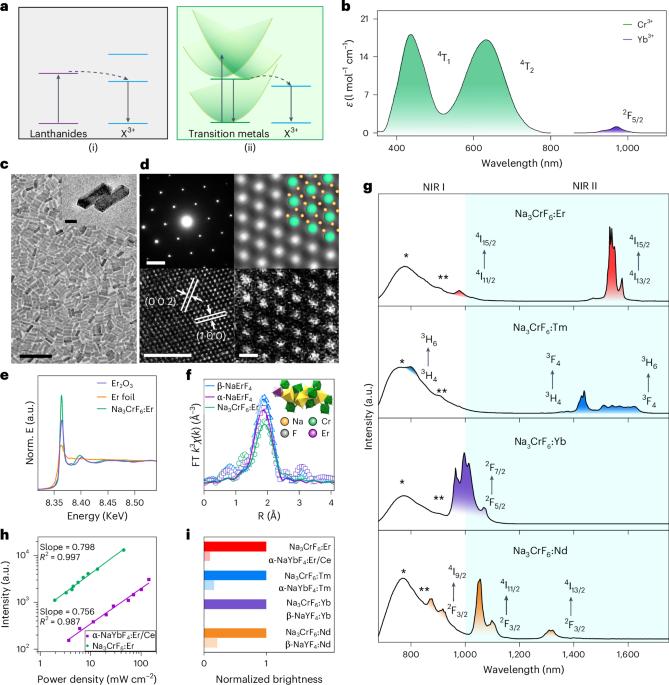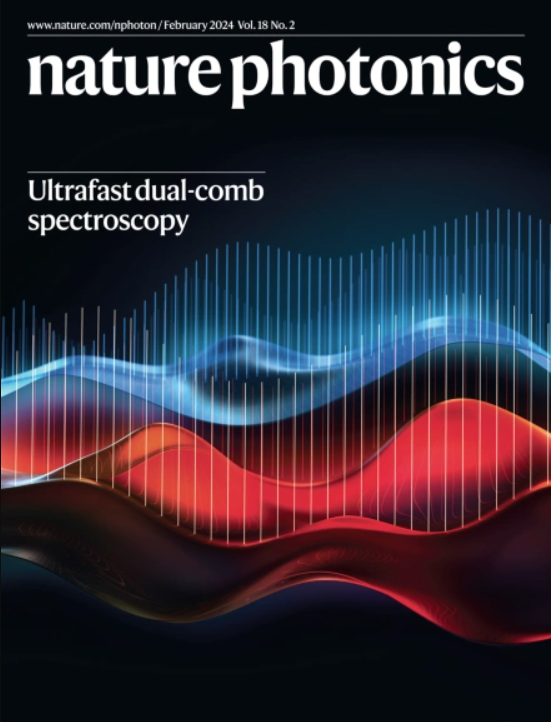高亮度过渡金属敏化镧系近红外发光纳米粒子
IF 32.3
1区 物理与天体物理
Q1 OPTICS
引用次数: 0
摘要
光通信、激光源和生物成像应用对近红外(700-1,700 纳米)材料的需求促使人们对掺杂镧系元素的纳米粒子进行了广泛的研究,因为它们具有纳米结构调制和界面特性可调性。然而,传统镧系元素敏化剂的摩尔消光系数较低,限制了镧系元素近红外纳米粒子在低功率激发场景中的应用亮度。在这里,我们介绍一种新型晶体纳米粒子 Na3CrF6,它既是镧系元素激活剂(Er3+、Tm3+、Yb3+ 或 Nd3+)的敏化剂,又是高亮度近红外发射的宿主。我们证明,与强度最高的传统镧系元素敏化纳米粒子相比,亮度最多可提高 370 倍。这一发现也验证了其他用低成本过渡金属(Mn2+ 或 Ni2+)敏化的掺杂镧系元素的纳米粒子。我们的过渡金属基纳米粒子是一个强大的工具箱,可利用低功率激发光源(如白光发光二极管或持久发光材料)实现高信噪比标记和成像。这项工作为下一代高亮度近红外发光系统铺平了道路,适合广泛的低照度激发应用。本文章由计算机程序翻译,如有差异,请以英文原文为准。


High-brightness transition metal-sensitized lanthanide near-infrared luminescent nanoparticles
The demand for near-infrared (700–1,700 nm) materials in optical communications, laser sources and biological imaging applications has led to extensive research on lanthanide-doped nanoparticles, owing to their nanostructure modulation and interface property tunability. However, the low molar extinction coefficient of conventional lanthanide sensitizers limits the brightness of lanthanide near-infrared nanoparticles for applications in low-power excitation scenarios. Here we introduce Na3CrF6, a new crystalline nanoparticle that serves as both sensitizer and host for high-brightness near-infrared emission from lanthanide activators (Er3+, Tm3+, Yb3+ or Nd3+). We demonstrate an increase in brightness of up to 370 times compared with the most intense conventional lanthanide-sensitized nanoparticles. This discovery is also validated for other lanthanide-doped nanoparticles sensitized with low-cost transition metals (Mn2+ or Ni2+). Our transition metal-based nanoparticles represent a powerful toolbox to enable high signal-to-noise-ratio labelling and imaging with low-power excitation sources such as white light-emitting diode or persistent luminescence materials. This work paves the way for next-generation high-brightness near-infrared luminescence systems, suited for a wide range of low-illumination excitation applications. Cr3+-sensitized lanthanide-doped nanoparticles afford high-brightness luminescence in the near-infrared region for applications in in vivo non-invasive bioimaging.
求助全文
通过发布文献求助,成功后即可免费获取论文全文。
去求助
来源期刊

Nature Photonics
物理-光学
CiteScore
54.20
自引率
1.70%
发文量
158
审稿时长
12 months
期刊介绍:
Nature Photonics is a monthly journal dedicated to the scientific study and application of light, known as Photonics. It publishes top-quality, peer-reviewed research across all areas of light generation, manipulation, and detection.
The journal encompasses research into the fundamental properties of light and its interactions with matter, as well as the latest developments in optoelectronic devices and emerging photonics applications. Topics covered include lasers, LEDs, imaging, detectors, optoelectronic devices, quantum optics, biophotonics, optical data storage, spectroscopy, fiber optics, solar energy, displays, terahertz technology, nonlinear optics, plasmonics, nanophotonics, and X-rays.
In addition to research papers and review articles summarizing scientific findings in optoelectronics, Nature Photonics also features News and Views pieces and research highlights. It uniquely includes articles on the business aspects of the industry, such as technology commercialization and market analysis, offering a comprehensive perspective on the field.
 求助内容:
求助内容: 应助结果提醒方式:
应助结果提醒方式:


